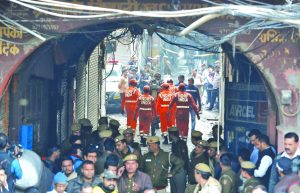 With authorities cracking down on factories following inadequate fire security norms after the Anaj Mandi factory tragedy, the lives of many workers in Delhi have come to a standstill. The Anaj Mandi factory fire had engulfed 43 lives and left over 50 critical, and the facility was found to have no fire security system in place.
With authorities cracking down on factories following inadequate fire security norms after the Anaj Mandi factory tragedy, the lives of many workers in Delhi have come to a standstill. The Anaj Mandi factory fire had engulfed 43 lives and left over 50 critical, and the facility was found to have no fire security system in place.
“Life would not be the same for us (migrant workers) since the Malik (owners) have decided to keep the factories closed for God knows how many days to avoid any action against them,” says Altaf (20) who has come from Bihar to work in a belt factory.
Around 25 per cent people in the industrial areas of Delhi are the migrant labourers from Jharkhand, Bihar and Uttar Pradesh, mostly in the age group of 15-35. Dearth of adequate opportunities to make use of their skills and less wage in their home states are main reasons for labourers to migrate to the National Capital.
“Whatever happened was unfortunate. This could have happened with us. But, we are helpless, in need of money and owners understand our weakness,” Altaf adds.
On the early winter morning of December 8, people of Anaj Mandi, Delhi, woke up to the screams for help from people entrapped in the smoke billowing from a fire that had broken out in the neighbouring building. The tragedy engulfed 43 lives and left over 50 critical who are being treated at LNJP hospital, RML Hospital, Lady Hardinge and Hindu Rao Hospital.
A sight of distress and chaos surrounded the areas of Anaj Mandi and the hospitals with the presence of panic-stricken relatives looking for their kin.
Locals claim that the fire accident could have been averted and 43 lives could have been saved had there been adequate fire safety norms in place.
The Anaj Mandi factory fire shows callous attitude of the factory owners who defy the mandatory factory and labour norms of safety, health, wage, compensation, etc. Dozens of residential buildings in Anaj Mandi house karkhanas (workshops) of accessories, running illegally right under the nose of police and local administration. It was later found that the building in which the 43 labourers died had inadequate ventilation also, and most of the deaths were reported to be due to asphyxia. The labourers were caught unawares as the fire gave them no time to escape, and had reportedly been sleeping.
The grieving families of the deceased reported frantic calls of the victims as the fire started going out of control inside the building. The labourers had been calling their families and anyone who they thought would help to save themselves from engulfing flames. The exit gates were inaccessible as fire started engulfing every part of the building, making it impossible for the victims to leave. Reportedly, 35 of the 43 people dead in the tragedy are from Bihar, hailing from poor backgrounds. Ambulances carrying the bodies of the victims left Delhi for Bihar, as the kin of dead labourers expressed shock and disbelief at what had befallen them.
The blame games had started in Delhi political circles as the politicians rushed to show their sympathy to the families of the victims. As the news spread over the social media, there was widespread outrage over the carelessness of the authorities, which had once again failed to check the fire safety norms on time. The Municipal Corporation of Delhi blamed the police for being non-cooperative in raiding illegal factories in Filmistan’s Anaj Mandi.
Whereas, some locals complain that it is the responsibility of MCD to check on the illegal factories that operate inside residential houses, and take proper action against them.
“They know this very well that there are dozen of small factories inside these residential buildings which operate in an extremely hazardous condition, still they (MCD) don’t take any action,” says Seema (43), a residential of Anaj Mandi.
A team of 30 fire tenders, NDRF and Police immediately initiated a rescue mission to douse off the fire and bring out the victims trapped inside the building. 6 ambulances were at work to move the victims to the hospital.
The owner of the factory has been booked by Delhi Police, as it was found that the factory had breached a number of mandatory safety norms. Rehan, who was running the bag manufacturing unit from a 200-yard plot in the crowded market, has been slapped with a case under section 304 of the Indian Penal Code (punishment for culpable homicide not amounting to murder).
Following the tragedy, the Delhi Chief Minister Arvind Kejriwal announced a relief of 10 lakh each for the families of the deceased, and 1 lakh for the injured. BJP’s Delhi Chief Manoj Tiwari also announced a compensation of 5 lakh for the deceased and 25,000 for the
injured. The relief from the centre was announced for 2 lakh each for the kin of those killed in the fire.
A petition was filed in the Delhi High Court on December 10 seeking the transfer of the case to the CBI and a thorough judicial inquiry into the incident. However, the court has struck down the petition, with the Division Bench saying the court will look into the incident if it finds lack of action on part of authorities in the incident. The Bench said the authorities were “already working to extinguish the fire and also deliberating to stop such incidents in future.” And it observed, that the city of Delhi is thickly populated, and such incidents happen in dense urbanised areas.
The court while reprimanding the petitioner observed that it was impossible to prefer a Petition in a day or two of the incident just by reading the newspaper, and said that it will give time to the authorities to find out facts.
“There is a procedure on how things work in a government department. There is no one-man show in the government. We see no reason to entertain in one or two days of the incident. If there is inaction on part of respondents, the incident in question, after a reasonable period, the court can look into it,” the court said.
letters@tehelka.com













